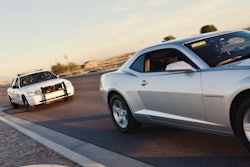There's a story that floats around in the world of defensive tactics trainers. It's a good story. It's good because it's funny and it's funny because it's true.
An aspiring cop—let's call him Joe—in the Detroit area had applied numerous times at numerous agencies but in the late 1970s his smaller size and stature precluded him from being hired on. At the time, most departments had a minimum height/weight of around 5-foot nine inches and 160 pounds. Joe wasn't that.
Joe eventually did become a cop, and he amassed more than three decades of experience in law enforcement. As his career progressed, he became a field training officer (FTO) and his department's lead use-of-force instructor. He became an expert in defensive tactics. He became somewhat famous.
One day on patrol, Joe and his rookie in field training heard a radio call from an officer working traffic.
The traffic cop was calling in a stop.
Joe turned to his trainee and said, "That's not normal"—traffic guys make 20 or more stops in a shift, and rarely call them in, he explained. So Joe turned his car in the direction of the stop, and soon heard over the radio, "Step it up, radio."
Joe and his rookie were now lights and sirens, en route.
The next thing over the radio was more urgent: "Send little Joe."
Thing was, there were four guys named Joe on the PD, including the chief. They were all more than six feet tall, but out of all the "Joes" working, this cop specifically asked for "Little Joe"—he wanted the guy who could help him the most at that time.
"Little Joe" Ferrara retired as a sergeant with Southfield (MI) Police Department and now serves as an instructor at the Oakland Police Academy in Michigan.
Anyone who has ever attended one of his classes knows the story of "Little Joe." Anyone who has ever been around "Little Joe" for any length of time knows to not judge him by his height of five-foot two inches and his compact, wiry frame.
"Little Joe" is no one to be trifled with, and he now trains officers of all sizes to be just like him.
Training a Smaller Stature Officer
"When we start talking about this topic—when we think about small—we think about me," Ferrara says. "Okay. Yeah. Great. But the fact is, the small officer is any officer smaller than the person they have to subdue or control."
Ferrera says that no matter who you are and no matter what your size, if you're dealing with somebody stronger and/or bigger than you, you need at least one of five physiological factors on your side.
"You need to understand balance displacement. You need to understand leverage, especially in the area of joint locks and appendage manipulation. You need to understand distraction techniques. You need to understand motor dysfunction. And you need to understand stunning," Ferrara says.
Ferrara says that if an instructor is to place any of those elements as "number one" in that list, it would probably be distraction techniques.
"As long as they're focused on resisting you or hurting you and a hundred percent of their physical and mental energy are, you know, 'Beat up the little cop,' you've got a monster to fight. But if you can distract them…and disorient them…you're gonna sap their strength and their coordination" he says.
Lee Shaykhet, owner-operator at Shaykhet Training LLC—says, "Any kind of defensive tactics program should be designed with the idea that any person—regardless of their stature—should be able to get the subject under control efficiently, quickly without much effort. It shouldn't be based on muscle. The tactics, the techniques should be simple practical ones that can be applied by just about anybody. When the tactics are correct the issue of the physical sizes are basically irrelevant."
Shaykhet adds, "You don't want to confront the threat—whatever it might be—head-on. What you want to be able to do is get to what we call a position of advantage. In other words, when you have a threat that's presented to you and you have to somehow address it, you slide behind the subject's back. From that point, you have an advantage."
Shaykhet likens this to the relationship between predator and prey.
"The buffalo is a lot bigger than the lion," Shaykhet says. "But the lion slides behind its back, you know, grabs it by the head, puts it on the ground. So it's the same idea. It's the same concept. It's not about size, it's about tactics."
Shaykhet adds, "If you try to control somebody head-on, that's the most difficult way of doing it—and unfortunately, that's how it's usually taught."
Diana Rathbourne—owner-operator at Rathborne Training LLC—says that no matter who is doing the training, while age and weight can be important, the trainer has to be cognizant of everyone's size.
"As a trainer, you just have to straight out say, 'Size matters'," She says. "In my background in martial arts, it comes down to attribute development and the big attributes are size, speed, and stamina. Some of those you can counter for and some you can't."
Much of that "counter" can—and usually does—come in the form of better, more refined, more diverse, and more practiced techniques.
Rathbourne explains, "One thing that law enforcement training does not do particularly well is give somebody a bailout. If what you're doing is not working, you need to have a back-up option, and then maybe a secondary backup option. Because not everything going to work on everybody."
Advantages of a Smaller Stature Officer
It may seem somewhat counterintuitive, but the smaller stature officer actually has some serious tactical advantages in the field, if they understand them and maximize them to their fullest potential.
A smaller officer—assuming they don't have "the cop look" or a "cop haircut"—often can work undercover or plainclothes assignments and blend in more easily than their larger stature counterparts. They take up less space and can use smaller objects for cover and concealment.
Shaykhet says that one basic advantage is that a small stature person usually moves better, faster, and more efficiently.
"You have some speed and agility advantages in a smaller stature officer," Shaykhet says.
Rathbourne says, "Have a plan going in. Think, 'This is my plan. This is my alternate plan.' Position yourself in the optimal place for you. Create the environment you want for you to perform."
Ferrara says, "When you are smaller than the person you're fighting, you have to take every advantage that you can. You can't just muscle through—you have to out technique them."
Ferrara adds that smaller stature officers can cultivate—and benefit from—the competence-confidence loop.
"The more competent you are in your skills, the more confident you look," Ferrara concludes. "And the more confident you look, the less likely they are to mess with you."
Finally—and perhaps most importantly—the smaller officer can be easily underestimated by an adversary who doesn't account for the old adage, "It's not the size of the dog in the fight, but the size of the fight in the dog."
















